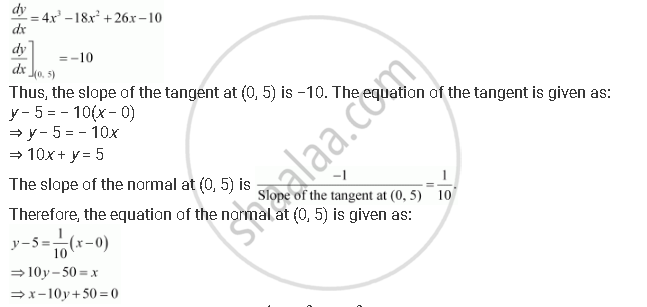Advertisements
Advertisements
प्रश्न
Find the equations of the tangent and normal to the given curves at the indicated points:
y = x4 − 6x3 + 13x2 − 10x + 5 at (0, 5)
उत्तर
The equation of the curve is y = x4 − 6x3 + 13x2 − 10x + 5.
On differentiating with respect to x, we get:

APPEARS IN
संबंधित प्रश्न
Find the equation of tangents to the curve y= x3 + 2x – 4, which are perpendicular to line x + 14y + 3 = 0.
Find the point on the curve y = x3 − 11x + 5 at which the tangent is y = x − 11.
Find the equations of all lines having slope 0 which are tangent to the curve y = `1/(x^2-2x + 3)`
Find the equations of the tangent and normal to the given curves at the indicated points:
y = x4 − 6x3 + 13x2 − 10x + 5 at (1, 3)
Find the equation of the normal to curve y2 = 4x at the point (1, 2).
Find the slope of the tangent and the normal to the following curve at the indicted point xy = 6 at (1, 6) ?
Find the values of a and b if the slope of the tangent to the curve xy + ax + by = 2 at (1, 1) is 2 ?
Find the points on the curve y2 = 2x3 at which the slope of the tangent is 3 ?
At what points on the curve y = x2 − 4x + 5 is the tangent perpendicular to the line 2y + x = 7?
Find the points on the curve \[\frac{x^2}{4} + \frac{y^2}{25} = 1\] at which the tangent is parallel to the x-axis ?
Find the points on the curve \[\frac{x^2}{9} + \frac{y^2}{16} = 1\] at which the tangent is parallel to x-axis ?
Find the equation of the tangent to the curve \[\sqrt{x} + \sqrt{y} = a\] at the point \[\left( \frac{a^2}{4}, \frac{a^2}{4} \right)\] ?
Find the equation of the tangent and the normal to the following curve at the indicated point y = x2 + 4x + 1 at x = 3 ?
Find the equation of the tangent and the normal to the following curve at the indicated point \[\frac{x^2}{a^2} - \frac{y^2}{b^2} = 1 \text { at } \left( a\sec\theta, b\tan\theta \right)\] ?
Find the equation of the tangent and the normal to the following curve at the indicated point 4x2 + 9y2 = 36 at (3cosθ, 2sinθ) ?
Find the equation of the tangent and the normal to the following curve at the indicated point \[\frac{x^2}{a^2} - \frac{y^2}{b^2} = 1 \text { at } \left( \sqrt{2}a, b \right)\] ?
Find an equation of normal line to the curve y = x3 + 2x + 6 which is parallel to the line x+ 14y + 4 = 0 ?
Find the angle of intersection of the following curve x2 + 4y2 = 8 and x2 − 2y2 = 2 ?
Show that the following curve intersect orthogonally at the indicated point x2 = 4y and 4y + x2 = 8 at (2, 1) ?
Show that the curves 2x = y2 and 2xy = k cut at right angles, if k2 = 8 ?
Prove that the curves y2 = 4x and x2 + y2 - 6x + 1 = 0 touch each other at the point (1, 2) ?
If the tangent line at a point (x, y) on the curve y = f(x) is parallel to x-axis, then write the value of \[\frac{dy}{dx}\] ?
If the tangent line at a point (x, y) on the curve y = f(x) is parallel to y-axis, find the value of \[\frac{dx}{dy}\] ?
Write the equation on the tangent to the curve y = x2 − x + 2 at the point where it crosses the y-axis ?
Write the angle between the curves y = e−x and y = ex at their point of intersections ?
If the tangent to the curve x = a t2, y = 2 at is perpendicular to x-axis, then its point of contact is _____________ .
At what point the slope of the tangent to the curve x2 + y2 − 2x − 3 = 0 is zero
Find the equation of a tangent and the normal to the curve `"y" = (("x" - 7))/(("x"-2)("x"-3)` at the point where it cuts the x-axis
Find the angle of intersection of the curves y2 = x and x2 = y.
Show that the equation of normal at any point on the curve x = 3cos θ – cos3θ, y = 3sinθ – sin3θ is 4 (y cos3θ – x sin3θ) = 3 sin 4θ
Find the co-ordinates of the point on the curve `sqrt(x) + sqrt(y)` = 4 at which tangent is equally inclined to the axes
Find the angle of intersection of the curves y = 4 – x2 and y = x2.
The curve y = `x^(1/5)` has at (0, 0) ______.
The line y = x + 1 is a tangent to the curve y2 = 4x at the point
If the curves y2 = 6x, 9x2 + by2 = 16, cut each other at right angles then the value of b is ______.
The normals to the curve x = a(θ + sinθ), y = a(1 – cosθ) at the points θ = (2n + 1)π, n∈I are all ______.
